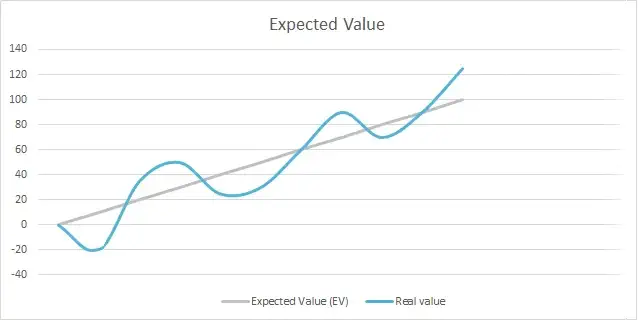This article confidently elucidates the concept of Expected Value in sports betting, offering clear insights into its calculation. Furthermore, it delves into the notion of positive Expected Value and illuminates its distinction from the house edge found on betting sites.
Expected value stands as a pivotal statistical concept and a crucial indicator in the realm of games of chance. Specifically within the domain of sports betting, the expected value of a wager holds unique nuances in its application. This article confidently defines expected value in the context of sports betting, provides a clear interpretation, and underscores its strategic importance.
The General Formula of the Expected Value

In every game of chance, bets are at the heart of the action. Whether you’re placing chips on a roulette table, rolling dice in craps, trying your luck in blackjack, or spinning a slot machine, a bet is in play. These bets hinge on the belief that a specific outcome will occur (as in roulette, craps, slots, video poker, or sports betting) or that you’ll outsmart the house, dealer, or other players (as in blackjack, baccarat, poker, card games, or backgammon).
Each bet comes with a stake and payout odds. When it’s possible to assign a mathematical probability to the event we’re betting on, the formula for expected value (EV) takes shape:
EV = (probability of winning x net profit if you win) + (probability of losing x loss if you lose)
(keeping in mind that losses are considered as negative values)
Embedded within this EV formula are the payout odds and the stake, determining the net profit and loss values.
The EV of a bet is a reflection of the long-term profit or loss it brings. However, it’s important to understand that this interpretation isn’t to be taken at face value. The EV is a statistical average due to the involvement of probability in its definition. While it characterizes a bet, it can’t predict your exact profit or loss over a set number of games. It simply indicates that as you make more such bets under the same conditions, your actual profit or loss will tend to approach the theoretical value of the EV.
The EV can be effortlessly represented as a percentage relative to the stake:
EV(%) = EV/stake (%)
In this percentage format, the EV isn’t tethered to a specific stake but applies universally, devoid of any currency denomination.
For instance, an EV of -2% for a bet signifies that, over the long haul, the bet will result in an overall loss of 2% of your total wagers.
Alternatively, the EV can be expressed in terms of the house’s advantage, aptly known as the house edge:
The house edge (HE) is the inverse of EV: HE = -EV
When the EV takes a negative value, the HE turns positive, serving as statistical assurance for the house that the bet will yield them profits over time.
The Formula of the EV in Sports Betting
In the realm of sports betting, the fundamental EV formula holds its ground. However, calculating the EV of a bet in sports betting differs in its reliance on probability. Unlike casino games, where precise probabilities can be computed, sports betting often lacks the mathematical certainty required for input into the EV formula.
In casino games, we can meticulously analyze the probabilities, thanks to our comprehensive knowledge of the game dynamics and outcome distribution within the random experiment’s sample space. In contrast, sports events are influenced by a multitude of intricate physical factors that defy complete mathematical quantification and often remain undetected. These events lean more toward determinism than stochasticity. Still, various subjective or experimental measures come into play, accounting for the likelihood of outcomes, effectively taking on the role of subjective probabilities.
Players’ personal analysis and information, along with software algorithms tailored for assessing outcome probabilities, come into play. These programs provide objective or subjective likelihoods but fall short of offering precise mathematical probabilities, often referred to as ‘true odds.’
Using these objective likelihoods as a stand-in for true odds becomes a means of estimating the EV of a sports bet.
Let’s formulate the general EV equation for a sports bet:
If ‘p’ represents the probability of the predicted outcome, ‘s’ denotes the stake, and ‘o’ signifies the payout odds (in decimal format), then the expected value of the bet can be expressed as:
EV = [p x (o – 1) x s] – [(1 – p) x s] = s x (p x o – 1)
Or, as a percentage of the stake:
EV(%) = p x o – 1 (%)
Zeroing in on the EV expression, we find that it equates to zero if and only if ‘p x o’ equals 1, indicating that the true odds (with ‘p’ expressed in odds format) match the bookie’s odds (‘o’). Such a bet, meeting this condition, would result in break-even performance in the long run, ensuring the bettor neither gains nor loses when p x o equals 1. Replacing ‘p’ with implied probability yields the same result, as implied probability serves as an alternate representation of payout odds.
To perform a precise and meaningful calculation of expected value (EV), it’s imperative to input an objective likelihood, which can be determined either through our own expert estimation or by utilizing specialized software.
Let’s illustrate this with an example:
Imagine you’re looking to assess the EV of a wager on the favored team in a soccer match, with odds of 1.68 for their victory. Let’s assume your analysis or software indicates a 65% probability of that team winning. The 1.68 decimal odds translate to an implied probability of 59.52%.
Now, armed with these essential inputs, we can calculate the EV:
EV(%) = p x o – 1 (%) = (65/100) x 1.68 – 1 = 0.092 = 9.20%.
In this case, we’ve derived a positive expected value, signifying that if you were to place this type of bet (under the same conditions) over the long term, you could anticipate winning an average of 9.20% of your total stake.
The reason for this positive EV is that your estimated probability surpasses the implied probability, creating a favorable outlook for this wager.
Positive Expected Value in Sports betting

In the world of gambling, both expected value (EV) and probability play pivotal strategic roles. Expected value serves as the statistical compass guiding us toward maximizing profits and minimizing losses over the long haul. The key to success lies in identifying situations and actions that offer the highest expected value for our bets.
It’s important to note that, in casino games, the relationship between EV and the house edge (HE) is crucial. The EV is essentially the opposite of the HE, with a positive EV in a bet potentially posing a risk to the house’s bottom line. This is precisely why you won’t often encounter bets with positive expectations in casinos, with a few exceptions, notably in the game of blackjack where optimal strategies can tip the scales in your favor.
Now, when it comes to sports betting, the art of selecting bets with apparent positive EV hinges on the bettor’s own analysis and evaluation skills. By comparing the bookie’s implied odds with your calculated true odds, you can exploit discrepancies and identify bets with a positive EV. This is, in essence, the core strategy of successful sports betting: evaluate, select, and persist.
The heart of this strategy lies in evaluating the objective likelihood of outcomes and pinpointing bets where you believe the true odds are higher than the bookie’s odds. Formally, these are bets for which ‘p’ (probability) > 1/’o’ (decimal odds), or equivalently, ‘p x o – 1’ > 0, signifying a positive EV.
The third component of this strategy, perseverance, is equally vital because realizing a positive expected value only materializes in the long run. Finding a bet with a positive EV doesn’t guarantee immediate or short-term wins but rather long-term profitability through consistently making such bets.
In stark contrast to other games of chance, the existence of positive EV bets in sports betting doesn’t threaten the bookmakers with bankruptcy. This is largely due to professional tools used by bookmakers for analysis and assessment, as well as their ability to adjust odds based on betting volume and outcomes balance. This ensures the bookmaker’s profitability even when positive EV bets are in play.
In casino games, the relationship between expected value and house edge is direct and precisely calculable. In the realm of sports betting, house edge (the counterpart of EV) remains elusive, primarily because the mathematical probability is often unknown. Instead, we encounter the concept of the “vigorish” (V), which is a cumulative result encompassing all potential outcomes of an event, as opposed to the singular focus of the house edge:
If an event has ‘n’ possible outcomes, each with payout odds ‘o1, o2, …, on’ (in decimal form), then:
V = 1/o1 + 1/o2 + … + 1/on – 1
In simpler terms, the vigorish is what exceeds one when summing up the implied probabilities associated with an event. It’s worth noting that the vigorish remains independent of the expected value of individual bets on specific outcomes.
Expected Value of Parlay bets
When you’re bundling multiple bets into a single wager, it’s common knowledge that the payout odds and the probability of winning such a bet are determined by the odds and probabilities associated with each individual outcome. Let’s delve into the expected value (EV) of a parlay bet and how it relates to the payout odds and probabilities of its component bets.
For the sake of simplicity, let’s consider a parlay bet comprising just two individual bets. We’ll label these bets as O1 and O2, each with its respective payout odds, o1 and o2, and probabilities of success, p1 and p2. The stake for this combined bet is ‘s.’ To calculate the EV of this parlay, we need to account for all possible scenarios regarding outcomes, including:
- Both O1 and O2 occurring (O1 ^ O2).
- O1 occurring while O2 does not (O1 ^ / O2).
- O1 not occurring while O2 does ( / O1 ^ O2).
- Neither O1 nor O2 occurring ( / O1 ^ / O2).
The table below illustrates the potential profit or loss and the associated probabilities for each of these four events:
| Event | O1 ^ O2 | O1 ^ / O2 | / O1 ^ O2 | / O1 ^ / O2 |
| Profit/Loss | s . (o1 . o2 – 1) | -s | -s | -s |
| Probability | p1 . p2 | p1 . (1 – p2) | (1 – p1) . p2 | (1 – p1) . (1 – p2) |
By multiplying the profit/loss and probability for each column and summing them, we arrive at the EV. After some algebraic simplification, the formula is as follows:
EV = s . (o1 . o2 . p1 . p2 – 1)
Or, expressed as a percentage of the stake:
EV (%) = o1 . o2 . p1 . p2 – 1 (%)
If the parlay bet involves more than two individual bets, a similar formula applies, where the entire product of odds and probabilities takes the form of the first term in the equation.
Let’s revisit a crucial aspect: when we replace mathematical probabilities with implied probabilities, the resulting product equals 1, rendering the expected value (EV) null, signifying a breakeven scenario.
Consider the following example involving a parlay bet drawn from Serie A matches:
- Match 1. Fiorentina – Cagliari: 1. Odds: 1.44
- Match 2. Turin – Verona: X. Odds: 3.40
- Match 3. Salernitana – Inter: 2. Odds: 1.43
Now, let’s assume you’ve estimated the following probabilities for these outcomes:
p1 = 53%; p2 = 45%; p3 = 60%
Plugging these values into the EV formula for the parlay bet:
EV (%) = 1.44 x 3.40 x 1.43 x (53/100) x (45/100) x (60/100) – 1 = 0.001 = 0.1%
The EV of a parlay bet serves not only as a statistical reference but also as a strategic tool, influencing the decision of whether to place your selections as a parlay or individual bets. This choice hinges on a multitude of factors, including your betting objectives, style, and the specifics of your selection.
Conclusion
In the realm of sports betting, the concept of expected value carries the same weight as it does in casino games. However, a key distinction arises in the world of sports betting: the expected value can’t be pinpointed with mathematical precision due to its reliance on subjective probabilities. Additionally, unlike casino games, the expected value isn’t directly tied to the house edge but rather finds its counterpart in the form of the vigorish, expressed through payout odds.
Nonetheless, the expected value plays a strategic role in sports betting, much like its role in casino gaming. What sets it apart is that, in sports betting, opportunities for positive-expectation bets are more readily discernible, provided one can make objective and accurate assessments.













